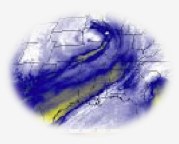How do NASA scientists use geometry and measurement to predict the behavior of dangerous solar storms?
Use the problems in the NES featured lesson, Geometry: Space Math Problems — Solar Storms, to bring relevance to your classroom by connecting your lesson to recent solar activity. In these problems, students analyze images of a solar tsunami and use geometry and measurement skills to find the speed of the wave. They step into the shoes of a NASA scientist and use geometry to find the speed of a coronal mass ejection, or CME, also known as a solar storm. CMEs can have hazardous effects on the International Space Station and astronauts.

 The Moderate Resolution Imaging Spectroradiometer, or MODIS, on NASA’s Aqua satellite and the MODIS sensor on NASA’s Terra satellite took photos of Japan’s earthquake and tsunami. Images were made with infrared and visible light to highlight the presence of water and other features on the ground.
The Moderate Resolution Imaging Spectroradiometer, or MODIS, on NASA’s Aqua satellite and the MODIS sensor on NASA’s Terra satellite took photos of Japan’s earthquake and tsunami. Images were made with infrared and visible light to highlight the presence of water and other features on the ground. Teachers, if you are looking for a way to demonstrate Newton’s Laws of Motion in a NASA context, the NASA Explorer Schools module Lunar Nautics may be just what you’re hoping to find. The three featured activities in this module focus on a real-world understanding of Newton’s laws. In the activity Rocket Staging: Balloon Staging, students learn how rockets achieve greater distances through rocket staging. The Lunar Landing: Swinging Tray activity shows students how gravity is responsible for keeping satellites in orbit. The purpose of Lunar Base Supply Egg Drop is for student teams to design a method of packaging “supplies” and getting them safely to a “lunar base.”
Teachers, if you are looking for a way to demonstrate Newton’s Laws of Motion in a NASA context, the NASA Explorer Schools module Lunar Nautics may be just what you’re hoping to find. The three featured activities in this module focus on a real-world understanding of Newton’s laws. In the activity Rocket Staging: Balloon Staging, students learn how rockets achieve greater distances through rocket staging. The Lunar Landing: Swinging Tray activity shows students how gravity is responsible for keeping satellites in orbit. The purpose of Lunar Base Supply Egg Drop is for student teams to design a method of packaging “supplies” and getting them safely to a “lunar base.” Here’s an extension activity from the MY NASA DATA project that you might want to use in your meteorology class. In the lesson Tropical Atlantic Aerosols, students use real satellite data to determine where the greatest concentrations of aerosols are located during the course of a year in the tropical Atlantic region and their source of origin. They explore data and draw conclusions about aerosol transport and learn about the radiation budget’s effects of aerosols.
Here’s an extension activity from the MY NASA DATA project that you might want to use in your meteorology class. In the lesson Tropical Atlantic Aerosols, students use real satellite data to determine where the greatest concentrations of aerosols are located during the course of a year in the tropical Atlantic region and their source of origin. They explore data and draw conclusions about aerosol transport and learn about the radiation budget’s effects of aerosols. Here is a great idea for the Messenger: Staying Cool — My Angle on Cooling Effects of Distance and Inclination module. Your students can create solar “cookers.” One of the variables is choosing how the sun enters the cooker, either directly or at an angle. Share with us on NEON your students/ results.
Here is a great idea for the Messenger: Staying Cool — My Angle on Cooling Effects of Distance and Inclination module. Your students can create solar “cookers.” One of the variables is choosing how the sun enters the cooker, either directly or at an angle. Share with us on NEON your students/ results. Astronauts aboard STS-133 are wrapping up a series of scheduled spacewalks, or extravehicular activities. When astronauts venture outside of their spacecraft, they need spacesuits to protect them from the solar radiation, the cold temperatures of space and fast-moving particles called micrometeoroids.
Astronauts aboard STS-133 are wrapping up a series of scheduled spacewalks, or extravehicular activities. When astronauts venture outside of their spacecraft, they need spacesuits to protect them from the solar radiation, the cold temperatures of space and fast-moving particles called micrometeoroids.